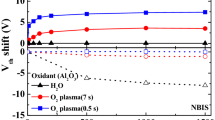Abstract
This work describes the influence of constant current stress induced degradation in reactively sputtered Ta2O5 thin film in pure argon and argon plus nitrogen within plasma. Capacitors were fabricated and the interface was characterized using I-V and C-V methods. X-ray diffraction (XRD) technique revealed the presence of N2 content in Ta2O5 films. A comparison between Ta2O5 films doped with and without N2 with respect to flat band shift and leakage current density is also presented. Post deposition annealing at 650° CreducesO/Ta ratio because of the formation of suboxides. It results in high quality TaOx film with high capacitance and low leakage current. On being stressed, flat band voltage in annealed devices shifts towards negative direction as a result positive charge traps are observed in high-k thin films. Incorporation of nitrogen in Ta2O5 dielectric films retain the intrinsic effect that significantly diminish the electron leakage current through deactivating the Vo (oxygen vacancy) related gap states.
Access this chapter
Tax calculation will be finalised at checkout
Purchases are for personal use only
Similar content being viewed by others
References
S.H. Lo, D.A. Buchanan, Y. Taur, W. Wang, Quantum-mechanical modeling of electron tunneling current from the inversion layer of ultra-thin-oxide nMOSFET’s. IEEE Electron Device Lett. 18(5), 209–211 (1997)
G.D. Wilk, R.M. Wallace, J.M. Anthony, High-κ gate dielectrics: current status and materials properties considerations. J. Appl. Phys. 89(10), 5243–5275 (2001)
R.M. Wallace, G.D. Wilk, High-κ dielectric materials for microelectronics. Crit. Rev. Solid State Mater. Sci. 28(4), 231–285 (2003)
M. Houssa, M. Naili, V.V. Afanas’ev, M.M. Heyns, A. Stesmans, Electrical and physical characterization of high-k dielectric layers, in Proceedings of IEEE International Symposium on VLSI Technology, Systems, and Applications, pp. 196–199 (2001)
R.M. Wallace, G. Wilk, Alternative gate dielectrics for microelectronics. MRS Bull. 27(3), 186–191 (2002)
S.P. Garg, N. Krishnamurthy, A. Awasthi, M. Venkatraman, The O–Ta (oxygen–tantalum) system. J. Phase Equilibria 17(1), 63–77 (1996)
M.M. Howard, C.A. Ventrice, H. Geisler, D.A. Hite, P.T. Sprunger, Growth morphology and electronic structure of ultra-thin TaOx films on Ag (100), in MRS Online Proceedings Library Archive, vol. 623 (2000)
H. Sawada, K. Kawakami, Electronic structure of oxygen vacancy in Ta2O5. J. Appl. Phys. 86(2), 956–959 (1999)
A.P. Huang, P.K. Chu, Improvement of interfacial and dielectric properties of sputtered Ta2O5 thin films by substrate biasing and the underlying mechanism. J. Appl. Phys. 97(11), 114106 (2005)
E. Atanassova, A. Paskaleva, Breakdown fields and conduction mechanisms in thin Ta2O5 layers on Si for high density DRAMs. Microelectron. Reliab. 42(2), 157–173 (2002)
E. Atanassova, D. Spassov, Hydrogen annealing effect on the properties of thermal Ta2O5 on Si. Microelectron. J. 30(3), 265–274 (1999)
Y.S. Kim, M.Y. Sung, Y.H. Lee, B.K. Ju, M.H. Oh, The influence of surface roughness on the electric conduction process in amorphous Ta2O5 thin films. J. Electrochem. Soc. 146(9), 3398–3402 (1999)
T. Hori, Gate Dielectric and MOS ULSI. Principles, Technologies and Applications. In Springer Series in Electronics and Photonics, vol. 34 (1997)
W.K. Choi, L.S. Tan, J.Y. Lim, S.G. Pek, Electrical characterisation of RF sputtered tantalum oxide films rapid thermal annealed with Ar, N2, O2 and N2O. Thin Solid Films 343, 105–107 (1999)
K.H. Goh, H.J. Lee, S.K. Lau, P.C. Teh, S. Ramesh, C.Y. Tan, Y.H. Wong, Investigation of the effect of anodization time and annealing temperature on the physical properties of ZrO2 thin film on a Si substrate. Mater. Res. Express 4(8), 086414 (2017)
S. Knebel et al. Reliability comparison of ZrO2 based DRAM High-k dielectrics under DC and AC Stress. IEEE Trans. Device Mater. Reliab. (2017)
H.E. Cheng, C.T. Mao, The effect of substrate temperature on the physical properties of tantalum oxide thin films grown by reactive radio-frequency sputtering. Mater. Res. Bull. 38(14), 1841–1849 (2003)
E. Atanassova, A. Paskaleva, High temperature N/sub 2/annealing-a promising way for improving the structure of Ta/sub 2/O/sub 5/and its interface with Si, in 24th IEEE International Conference on Microelectronics, vol. 2 (2004), pp. 467–470
Y.S. Lai, K.J. Chen, J.S. Chen, Investigation of the interlayer characteristics of Ta2O5 thin films deposited on bare, N2O, and NH3 plasma nitridated Si substrates. J. Appl. Phys. 91(10), 6428–6434 (2002)
U. Kashniyal, K.P. Pandey, Stress induced degradation and reliability of Al2O3 thin film on silicon. Vacuum 152, 109–113 (2018)
E.H. Nicollian, J.R. Brews, MOS (Metal Oxide Semiconductor) Physics and Technology (Wiley, New York, 1982)
A. Rao, J. D’sa, S. Goyal, B.R. Singh, Conduction and field induced degradation in thin ZrO2 films sputtered in nitrogen containing plasma on silicon. J. Mater. Sci.: Mater. Electron. 25(3), 1583–1588 (2014)
N.K. Ponon, D.J.R. Appleby, E. Arac, P.J. King, S. Ganti, K.S.K. Kwa, A. O’Neill, Effect of deposition conditions and post deposition anneal on reactively sputtered titanium nitride thin films. Thin Solid Films 578, 31–37 (2015)
Acknowledgements
Authors thank Prof. B. R. Singh, IIIT-Allahabad for his constant support and encouragement.
Author information
Authors and Affiliations
Corresponding author
Editor information
Editors and Affiliations
Rights and permissions
Copyright information
© 2019 Springer Nature Switzerland AG
About this paper
Cite this paper
Kashniyal, U., Pandey, K.P. (2019). Stress Induced Degradation of High-k Gate Dielectric Ta2O5 Thin Films on Silicon. In: Sharma, R., Rawal, D. (eds) The Physics of Semiconductor Devices. IWPSD 2017. Springer Proceedings in Physics, vol 215. Springer, Cham. https://doi.org/10.1007/978-3-319-97604-4_92
Download citation
DOI: https://doi.org/10.1007/978-3-319-97604-4_92
Published:
Publisher Name: Springer, Cham
Print ISBN: 978-3-319-97603-7
Online ISBN: 978-3-319-97604-4
eBook Packages: Physics and AstronomyPhysics and Astronomy (R0)




